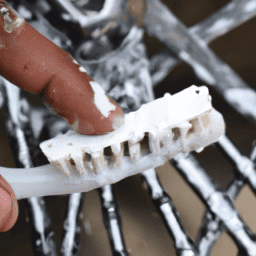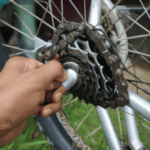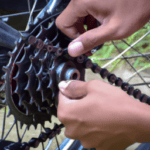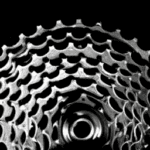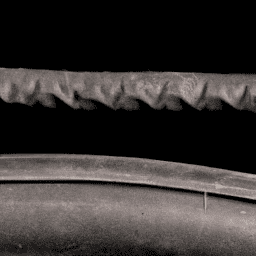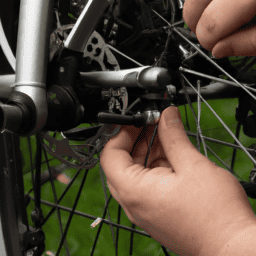Have you observed a decline in your bike’s performance?
Are you struggling to change gears smoothly?
One possible reason for these issues could be a dirty cassette.
The cassette is a vital component of your bike’s drivetrain, and it’s essential to keep it clean to ensure optimal performance.
In this article, we will guide you through the process of cleaning your bicycle cassette.
To begin with, you will need some tools, including a chain whip, cassette lockring tool, degreaser, a brush, and a clean rag.
Don’t worry if you don’t have all of these tools; they are readily available and won’t break the bank.
With these tools, you can remove the cassette, clean it, and reinstall it in no time.
By following the steps outlined in this article, you will be able to keep your bike’s cassette clean and running smoothly, ensuring an enjoyable and efficient ride.
Key Takeaways
- Regular cleaning and lubrication of bike cassette is crucial for optimal performance and longer lifespan.
- Tools required for cleaning bike cassette include chain whip, cassette lockring tool, degreaser, brush, and clean rag.
- Types of degreasers include solvent-based and water-based, and it is important to avoid getting degreaser on braking surfaces and chain.
- Regular maintenance tips include proper lubrication and rust prevention, as well as regular cleaning for optimal performance and to prevent costly repairs.
Gather the Necessary Tools
Now, you’ll want to gather all the tools you need to get your bike cassette sparkling clean! The first thing you’ll need is a good quality degreaser.
There are different types of degreasers on the market, so make sure you get one that is specifically designed for bike chains and cassettes. Avoid using household degreasers as they can be too harsh and damage your bike’s components.
You may also want to consider getting a chain cleaner tool as it can help make the cleaning process easier and more efficient. It’s also important to use gloves when cleaning your bike cassette.
Degreasers can be harsh on your skin, and you don’t want to expose yourself to any harmful chemicals. You can use latex gloves or any other type of protective gloves that are chemical-resistant.
Once you have all the necessary tools, you’re ready to move on to the next step of removing the cassette.
Remove the Cassette
First, firmly fasten the freewheel remover onto the cassette. Use a wrench to hold the freewheel remover in place while turning the cassette removal tool counter-clockwise. Once the cassette is loose, carefully remove it from the wheel. Be mindful of the spacers between each cog and keep them in order so that they can be replaced in the correct position.
Proper lubrication is essential for the longevity of your cassette. Before cleaning the cassette, inspect it for signs of wear, such as bent or missing teeth. If you notice any damage, it may be time to replace the cassette. However, if the cassette’s in good condition, you can clean it using a degreaser and a stiff-bristled brush. Once the cassette’s clean, you can reassemble it onto the wheel and proceed with the next step of properly lubricating it.
Now that you’ve removed the cassette and inspected it for wear, it’s time to clean it thoroughly.
Clean the Cassette
Now that you’ve removed the cassette from your bike, it’s time to clean it thoroughly. Start by using a degreaser to break down any buildup of grime or grease on the cassette.
Use a stiff-bristled brush to scrub the cassette thoroughly, paying close attention to the cogs and spaces between them.
Rinse the cassette with clean water and dry it thoroughly before re-installing it on your bike.
Using a Degreaser
To get your bicycle cassette sparkling clean, you’ll want to use a degreaser – it’s a quick and efficient way to remove all the grime and dirt that accumulates over time.
There are two types of degreasers you can choose from: solvent-based or water-based. Solvent-based degreasers are more powerful and can dissolve tougher grime, but they’re more toxic and require careful handling. Water-based degreasers are less powerful but are safer to use and easier to clean up.
When applying the degreaser, make sure to avoid getting it on the braking surfaces and the chain.
Apply the degreaser to the cassette, let it sit for a few minutes, and then use a stiff-bristled brush to scrub away the grime. Make sure to get in between each sprocket and clean the teeth thoroughly.
Once you’re done, rinse the cassette with water and dry it off with a clean cloth.
With the cassette clean, you can move on to the next step of scrubbing with a brush to get your bike in top shape.
Scrubbing with a Brush
Using a stiff-bristled brush is an effective way to scrub away any remaining dirt and grime from the sprockets, resulting in a smoother and more efficient ride. Did you know that a clean and well-maintained bike can last up to twice as long as a neglected one?
When it comes to choosing a brush, there are different types available in the market. A toothbrush or a small brush with a pointed tip can be used to clean the tight spaces between the sprockets. A larger brush with stiff bristles can be used to scrub the larger flat surfaces. Make sure to choose a brush that’s appropriate for the size and shape of your cassette.
Cleaning solutions can also be used along with the brush to remove stubborn grime. A degreaser or a mild soap solution can be applied to the brush before scrubbing the cassette. Avoid using harsh chemicals that can damage the cassette’s surface. Scrub the cassette in a circular motion, starting from the center and working your way outwards.
Once you’re done scrubbing, rinse the cassette with clean water. In the next section, we’ll discuss how to properly rinse and dry your cassette.
Rinsing and Drying
After scrubbing your sprockets with a brush, it’s important to thoroughly rinse and dry them to prevent rust and corrosion from forming.
Start by spraying the cassette with a hose or using a bucket of water to rinse off any remaining debris. Use a soft brush to gently scrub the cassette, making sure to get into all the nooks and crannies. Be sure to rinse the cassette thoroughly, making sure there’s no detergent or soap residue left.
Once you’ve finished rinsing, it’s time to dry the cassette. Use a clean towel or rag to dry the cassette, making sure to remove any remaining moisture. Preventing rust is key, so make sure to lubricate the cassette after you’ve dried it. This’ll help prevent rust and corrosion from forming.
With your cassette now clean and dry, it’s time to move on to the next step: reinstalling the cassette.
Reinstall the Cassette
Now that the cassette’s cleaned, let’s get it back on the bike and feel the satisfaction of a smooth ride. Before you reinstall the cassette, make sure to inspect it for wear and tear. Look for any damage or worn teeth on the cassette, and check the cassette wear indicators if your cassette’s got them.
To reinstall the cassette, follow these steps:
- Apply proper lubrication to the cassette and hub threads before installing.
- Slide the cassette back onto the freehub body, aligning the splines on the cassette with those on the freehub.
- Tighten the lockring with a cassette lockring tool to the manufacturer’s recommended torque.
Once the cassette’s securely installed, you can move onto maintaining the rest of the bike’s components. Regular maintenance’s crucial to keep your bike running smoothly and prevent costly repairs down the road.
Maintenance Tips
To keep your ride running smoothly, it’s crucial to maintain your bicycle cassette regularly. One essential maintenance tip is to ensure the cassette is properly lubricated. Applying a small amount of lubricant to the cassette’s teeth and chain will prevent friction, allowing the cassette to spin smoothly and efficiently. It will also reduce wear and tear on the cassette, increasing its lifespan.
Another critical maintenance tip for your bicycle cassette is to prevent rust from forming. Rust can cause significant damage to your cassette, leading to a decrease in performance and potentially rendering it unusable. To prevent rust, you should keep your cassette clean and dry after riding in wet conditions. You can also apply a rust inhibitor to prevent rust from forming on the cassette’s metal components.
By following these maintenance tips, you can ensure your bicycle cassette performs at its best and lasts for many rides to come.
Frequently Asked Questions
How often should I clean my bicycle cassette?
You’ll want to clean your bicycle cassette regularly to keep it running smoothly. Regular cleaning ensures that dirt and grime don’t build up, which can lead to poor shifting and decreased lifespan. Avoid common mistakes like using harsh chemicals or not lubricating properly.
Can I use dish soap to clean my cassette?
Using dish soap for cassette cleaning has pros and cons. It can be effective, but may also leave residue. Other household items like degreasers or citrus-based cleaners can be safer options. Always use a brush and rinse thoroughly.
Do I need to remove my rear wheel to clean the cassette?
To clean your cassette without removing the rear wheel, use a stiff-bristled brush or rag with degreaser. Rotate the pedals backwards and clean each cog thoroughly. Alternatively, use a cassette cleaning tool. Ensure all dirt and grime are removed.
Should I lubricate my cassette after cleaning it?
Lubricating your cassette after cleaning has its pros and cons. Applying too much can attract dirt and grime, but not enough can cause wear and tear. Use a dry or wet lubricant for cassette maintenance.
How do I know if my cassette is worn out and needs to be replaced?
Your cassette is like a tire tread. Signs of wear include skipping or difficulty shifting. Options for replacement include buying a new cassette or replacing individual worn cogs. Consult a bike mechanic for precision.
Conclusion
Congratulations! You’ve successfully cleaned your bicycle cassette. You may feel a sense of accomplishment, knowing that you’ve taken care of your bike and ensured its longevity.
But more than that, you’ve also taken care of yourself. By maintaining your bicycle, you’ve ensured that it’s safe and efficient to ride, reducing the risk of accidents and injuries.
Furthermore, you’ve also helped to reduce your carbon footprint by keeping your bike in good condition and reducing the need for frequent replacements.
Remember to regularly clean and maintain your bicycle cassette to keep it in top shape. By doing so, you’re not only taking care of your bike but also taking care of yourself and the environment.
Keep up the good work!
